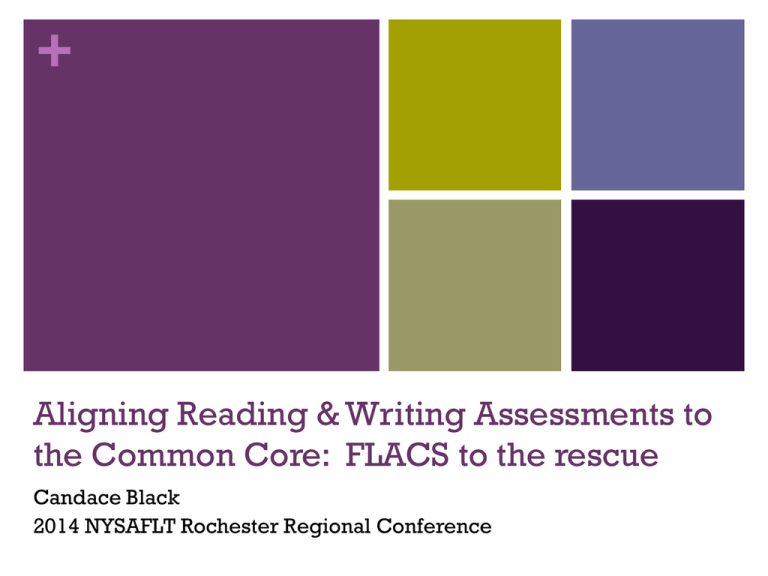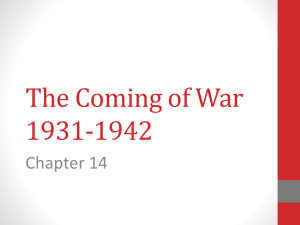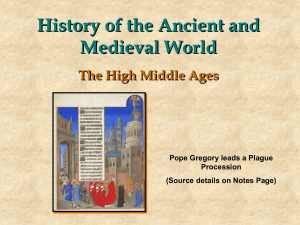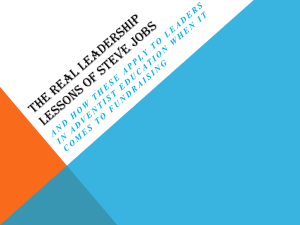Black - Aligning Reading Writing to CCSS
advertisement

+ Aligning Reading & Writing Assessments to the Common Core: FLACS to the rescue Candace Black 2014 NYSAFLT Rochester Regional Conference + Introductions – who are we? Level? Are you a Checkpoint A teacher? Are you a Checkpoint B teacher? Language? Are you a Spanish teacher? French? German? Italian? Latin? Chinese? Arabic? Or other? + Introductions – who are we? How many of you participate in an exam consortium to write exams each year? How many of your write your own Checkpoint A or B exams each year? How many of you know what FLACS is or use the FLACS exam? + Workshop Agenda Review of the Common Core State Standards for Reading/Writing Examples (Regents questions that meet the standards and new questions) Small group work time to develop sample text-based questions Large group share + Workshop Agenda How do we prepare our students for this new assessment? The FLACS exam – benefits & how to participate? + Changes to the implementation of the Common Core State Standards Recent delay in CC implementation = Class of 2022! Take advantage of this gift from NYSED to incorporate the CCSS into your LOTE lessons and assessments! + Reading in the Common Core There are 11 CCSS Reading standards. R3, R5, R6, and R10 are relatively complex – let’s relegate them to LOTE checkpoint C and/or English. Common Core State Standards for Literacy + Reading in the Common Core Standard R1 Reading Read closely to determine what the text says explicitly and to make logical inferences from it; cite specific textual evidence when writing or speaking to support conclusions drawn from the text. This person expresses his ideas through (1) dance (2) technology (3) sculpture (4) words + Reading in the Common Core Standard Reading R2 Determine central ideas or themes of a text and analyze their development; summarize key supporting details and ideas. What is being advertised? (1) a resort hotel (2) a music CD (3) a tourist discount card (4) a sightseeing cruise + Reading in the Common Core Standard R4 Reading Interpret words and phrases as they are used in a text, including determining technical, connotative, and figurative meanings, and analyze how specific word choices shape meaning or tone. What does the article say about meals delivered to the home in France? (1) They are not available. (2) They are not very popular. (3) They are considered nutritious. (4) They are imported from the United States. + Reading in the Common Core Standard Reading R8 Delineate and evaluate the argument and specific claims in a text, including the validity of the reasoning as well as the relevance and sufficiency of the evidence. According to this article, why did the Convention adopt the metric system in France? (1) to accept a peace treaty (2) to avoid confusion (3) to help navigators (4) to celebrate a national holiday + Reading in the Common Core Standard Reading R9 Analyze how two or more texts address similar themes or topics in order to build knowledge or to compare the approaches the authors take. We don’t really do this… yet. Which statement about this product is supported by both advertisements/passages? (1) It is very inexpensive. (2) It was invented by a teenager. (3) It can only be purchased online. (4) It has many different uses. + Reading in the Common Core Standard R11 Reading Interpret texts from a variety of genres and a wide spectrum of American and world cultures. We already do this, by definition! + Small group work time With a group of 2-4 people around you, choose a reading from the packet: Restaurant ad Want ad – job posting Develop a common core-aligned question for your reading. + Large group share + Writing in the Common Core There are 11 CCSS Writing standards. We do many of these already… W3 - Write narratives to develop real or imagined experiences or events using effective technique, well-chosen details, and wellstructured event sequences. + Writing in the Common Core Checkpoint A task (current) + Writing in the Common Core Here’s the difference… some of the CCSS require writing tasks that are text-based. W1 - Write arguments to support claims in an analysis of substantive topics or texts using valid reasoning and relevant and sufficient evidence. + Writing in the Common Core W8 - Gather relevant information from multiple print and digital sources, assess the credibility and accuracy of each source, and integrate the information while avoiding plagiarism. + Writing in the Common Core W9 - Draw evidence from literary or informational texts to support analysis, reflection, and research. + Writing in the Common Core So how will we prepare students for these new standards? Let’s look at how we could use our standard LOTE readings (short or long passages) to incorporate CCSS standards into our writing assessments. + Checkpoint A Writing + Checkpoint A Writing (CCSS) You are planning a party for your brother’s 13th birthday. Read the advertisements and write an e-mail to your friend discussing the location you would like to choose for the party. Include: The reasons for your selection The kinds of foods you will be serving Note that the student must make read the an passage argument and or offer include an opinion information AND justify (this isit.no longer just suggested). + Checkpoint A Writing (CCSS) What would an ideal student text look like? Student uses conventions appropriate Student offers opinion. to the text type chosen. Domenica è il compleanno di mio fratello. Io voglio avere la sua festa al ristorante “Italo’s”. Loro servono la carne e a mio fratello piace molto la bistecca. La domenica costa solo E 14.00 e possiamo mangiare molto. Possiamo anche ballare! Questo posto è perfetto. Io inviterò dieci dei suoi amici e ci divertiremo molto. Vuoi venire? Cara Maria, Student justifies opinion. Tanti baci, Francesca + New Checkpoint A Rubric FLACS Checkpoint A Rubric Implementation – September 2014 1st exams – June 2015 Dimension Purpose/task Vocabulary Structure/ conventions Word count 4 Satisfies the task, connects all ideas to task/purpose, refers to and incorporates many supporting details from source(s), and exhibits a logical and coherent sequence of ideas throughout. Utilizes a wide variety of vocabulary that expands the topic in the statement/question to include nouns, verbs, and/or adjectives, as appropriate to the task. Exhibits a high degree of control of structure/conventions: · Subject/verb agreement · Noun/adjective agreement · Correct word order · Spelling Errors do NOT hinder overall comprehensibility of the passage. Uses 50 or more comprehensible words in target language that contribute to the development of the task. Performance Level 3 Satisfies the task; connections are implied with few irrelevancies. Refers to and incorporates some supporting details from source(s). Utilizes a wide variety of vocabulary relevant to the topic in statements/questions to include nouns, verbs, and/or adjectives, as appropriate to the task. Exhibits some control of structure/conventions: · Subject/verb agreement · Noun/adjective agreement · Correct word order · Spelling Errors do NOT hinder overall comprehensibility of the passage. Uses 35-49 comprehensible words in target language that contribute to the development of the task. 2 Satisfies the task; connections may be unclear with some irrelevancies. Few supporting details or references to source(s) included. 1 Makes at least one statement which satisfies the task. Remaining statements are irrelevant to the task. Refers poorly to source(s) with no supporting details provided. Utilizes vocabulary, some of which is inaccurate or irrelevant to the task. Utilizes limited vocabulary, most of which is inaccurate or irrelevant to the task. Exhibits some degree of control of structure/conventions: · Subject/verb agreement · Noun/adjective agreement · Correct word order · Spelling Demonstrates little control of structure or convention, or errors impede overall comprehensibility of passage. Errors DO hinder overall comprehensibility of the passage. Uses 25-34 comprehensible words in target language that contribute to the development of the task. Uses 15-24 comprehensible words in target language that contribute to the development of the task. + FLACS Checkpoint A Rubric Implementation – September 2014 1st exams – June 2015 New Checkpoint A Rubric Dimension Purpose/task 4 Satisfies the task, connects all ideas to task/purpose, refers to and incorporates many supporting details from source(s), and exhibits a logical and coherent sequence of ideas throughout. Performance Level 3 2 Satisfies the task; connections Satisfies the task; connections are implied with few may be unclear with some irrelevancies. Refers to and irrelevancies. Few supporting incorporates some supporting details or references to details from source(s). source(s) included. 1 Makes at least one statement which satisfies the task. Remaining statements are irrelevant to the task. Refers poorly to source(s) with no supporting details provided. Satisfies the task, connects all ideas to task/purpose, refers to and incorporates many supporting details from source(s), and exhibits a logical and coherent sequence of ideas throughout. + FLACS Checkpoint A Rubric Implementation – September 2014 1st exams – June 2015 New Checkpoint A Rubric Dimension Purpose/task 4 Satisfies the task, connects all ideas to task/purpose, refers to and incorporates many supporting details from source(s), and exhibits a logical and coherent sequence of ideas throughout. Performance Level 3 2 Satisfies the task; connections Satisfies the task; connections are implied with few may be unclear with some irrelevancies. Refers to and irrelevancies. Few supporting incorporates some supporting details or references to details from source(s). source(s) included. 1 Makes at least one statement which satisfies the task. Remaining statements are irrelevant to the task. Refers poorly to source(s) with no supporting details provided. Satisfies the task; connections are implied with few irrelevancies. Refers to and incorporates some supporting details from source(s). + FLACS Checkpoint A Rubric Implementation – September 2014 1st exams – June 2015 New Checkpoint A Rubric Dimension Purpose/task 4 Satisfies the task, connects all ideas to task/purpose, refers to and incorporates many supporting details from source(s), and exhibits a logical and coherent sequence of ideas throughout. Performance Level 3 2 Satisfies the task; connections Satisfies the task; connections are implied with few may be unclear with some irrelevancies. Refers to and irrelevancies. Few supporting incorporates some supporting details or references to details from source(s). source(s) included. 1 Makes at least one statement which satisfies the task. Remaining statements are irrelevant to the task. Refers poorly to source(s) with no supporting details provided. Satisfies the task; connections may be unclear with some irrelevancies. Few supporting details or references to source(s) included. + FLACS Checkpoint A Rubric Implementation – September 2014 1st exams – June 2015 New Checkpoint A Rubric Dimension Purpose/task 4 Satisfies the task, connects all ideas to task/purpose, refers to and incorporates many supporting details from source(s), and exhibits a logical and coherent sequence of ideas throughout. Performance Level 3 2 Satisfies the task; connections Satisfies the task; connections are implied with few may be unclear with some irrelevancies. Refers to and irrelevancies. Few supporting incorporates some supporting details or references to details from source(s). source(s) included. 1 Makes at least one statement which satisfies the task. Remaining statements are irrelevant to the task. Refers poorly to source(s) with no supporting details provided. Makes at least one statement which satisfies the task. Remaining statements are irrelevant to the task. Refers poorly to source(s) with no supporting details provided. + Writing in the Common Core Checkpoint B task (current) + Checkpoint B Writing (CCSS) Single text + Checkpoint B Writing (CCSS) Single text Your family took a trip to Martinique this past winter. Write a blog about your trip to Martinique including details from the travel suggestions you read prior to your trip. OR Your family is planning a trip to Martinique. Write an email to your friend describing what you would like to do based on the travel suggestions. Note the revised text types (blog, email) which require the student to adjust language for audience (register). + Checkpoint B Writing (CCSS) Multiple texts + Checkpoint B Writing (CCSS) Multiple texts Your school is sponsoring a trip to France this summer. In addition to visiting Paris, your teacher is giving you the option of selecting another city in France to visit. Read the descriptions of the four cities, and write an email to your teacher using information from your articles to explain which city you would like to visit. Note that the student must read the passage and include information (no longer just suggested). Note that the student must make an argument/offer an opinion AND justify it. + New Checkpoint B Rubric FLACS Checkpoint B Rubric Implementation – September 2014 1st exams – June 2015 Dimension Purpose/task Organization (The extent to which response exhibits direction, shape, and coherence.) Vocabulary Structure/ conventions 4 Accomplishes the task; refers to and incorporates many details from source(s) – text, video, and/or audio - that support the development of the task, but there may be minor irrelevancies. Exhibits a logical and coherent sequence throughout, provides a clear sense of a beginning, middle and end. Makes smooth transitions between ideas. Includes a wide variety of vocabulary that expands the topic, but there may be minor inaccuracies. Demonstrates a high degree of control of Checkpoint B structure/conventions: · Subject/verb agreement · Present, past, future ideas expressed as appropriate · Noun/adjective agreement · Correct word order · Spelling/diacritical marks Errors do NOT hinder overall comprehensibility of the passage. Word count Performance Level 3 Accomplishes the task; refers to and includes some details from source(s) – text, video, and/or audio - that support the development of the task, but there may be some irrelevancies. Exhibits a logical sequence, provides a beginning, middle and end. Includes a variety of vocabulary related to the topic. Demonstrates some control of Checkpoint B structure/conventions: · Subject/verb agreement · Present, past, future ideas expressed as appropriate · Noun/adjective agreement · Correct word order · Spelling/diacritical marks Errors do NOT hinder overall comprehensibility of the passage. 2 Accomplishes the task; refers to and includes few details from source(s) – text, video, and/or audio - that support the development of the task. There are many irrelevancies. 1 Attempts to accomplish the task; makes some reference to source (text, video and/or audio), but provides few or no supporting details. Attempts to provide a logical sequence and/or the beginning or ending is abrupt or unclear. Utilizes little order; provides a series of separate and/or disconnected ideas. Includes basic vocabulary; some vocabulary may be inaccurate or unrelated to the topic. Demonstrates some control of Checkpoint B structure/conventions. Includes limited vocabulary and/or most vocabulary is inaccurate or unrelated to the topic. Demonstrates little control of Checkpoint A or B structure/conventions. Errors DO hinder overall comprehensibility of the passage and/or there are numerous Checkpoint A errors. Errors impede overall comprehensibility of the passage. OR Demonstrates a high degree of control, but uses only Checkpoint A structures/ conventions. Uses 100 or more comprehensible words in target language that contribute to the development of the task. Uses 50-99 comprehensible words in target language that contribute to the development of the task. + FLACS Checkpoint B Rubric Implementation – September 2014 1st exams – June 2015 New Checkpoint B Rubric Dimension Purpose/task Performance Level 4 3 Accomplishes the task; refers to Accomplishes the task; refers to and incorporates many details and includes some details from from source(s) – text, video, and/or source(s) – text, video, and/or audio - that support the audio - that support the development of the task, but there development of the task, but there may be minor irrelevancies. may be some irrelevancies. 2 Accomplishes the task; refers to and includes few details from source(s) – text, video, and/or audio - that support the development of the task. There are many irrelevancies. 1 Attempts to accomplish the task; makes some reference to source (text, video and/or audio), but provides few or no supporting details. Accomplishes the task; refers to and incorporates many details from source(s) – text, video, and/or audio that support the development of the task, but there may be minor irrelevancies. + FLACS Checkpoint B Rubric Implementation – September 2014 1st exams – June 2015 New Checkpoint B Rubric Dimension Purpose/task Performance Level 4 3 Accomplishes the task; refers to Accomplishes the task; refers to and incorporates many details and includes some details from from source(s) – text, video, and/or source(s) – text, video, and/or audio - that support the audio - that support the development of the task, but there development of the task, but there may be minor irrelevancies. may be some irrelevancies. 2 Accomplishes the task; refers to and includes few details from source(s) – text, video, and/or audio - that support the development of the task. There are many irrelevancies. 1 Attempts to accomplish the task; makes some reference to source (text, video and/or audio), but provides few or no supporting details. Accomplishes the task; refers to and includes some details from source(s) – text, video, and/or audio - that support the development of the task, but there may be some irrelevancies. + FLACS Checkpoint B Rubric Implementation – September 2014 1st exams – June 2015 New Checkpoint B Rubric Dimension Purpose/task Performance Level 4 3 Accomplishes the task; refers to Accomplishes the task; refers to and incorporates many details and includes some details from from source(s) – text, video, and/or source(s) – text, video, and/or audio - that support the audio - that support the development of the task, but there development of the task, but there may be minor irrelevancies. may be some irrelevancies. 2 Accomplishes the task; refers to and includes few details from source(s) – text, video, and/or audio - that support the development of the task. There are many irrelevancies. 1 Attempts to accomplish the task; makes some reference to source (text, video and/or audio), but provides few or no supporting details. Accomplishes the task; refers to and includes few details from source(s) – text, video, and/or audio - that support the development of the task. There are many irrelevancies. + FLACS Checkpoint B Rubric Implementation – September 2014 1st exams – June 2015 New Checkpoint B Rubric Dimension Purpose/task Performance Level 4 3 Accomplishes the task; refers to Accomplishes the task; refers to and incorporates many details and includes some details from from source(s) – text, video, and/or source(s) – text, video, and/or audio - that support the audio - that support the development of the task, but there development of the task, but there may be minor irrelevancies. may be some irrelevancies. 2 Accomplishes the task; refers to and includes few details from source(s) – text, video, and/or audio - that support the development of the task. There are many irrelevancies. 1 Attempts to accomplish the task; makes some reference to source (text, video and/or audio), but provides few or no supporting details. Attempts to accomplish the task; makes some reference to source (text, video and/or audio), but provides few or no supporting details. + Authentic texts to use with students • • • • • • • • • • 7 day weather forecasts Hotel descriptions Movie reviews Itineraries Schedules Exhibition blurbs Store ads Contest ads City street maps Age-appropriate articles + How do we prepare our students for this new assessment? Incorporate age-appropriate, but gradually more difficult reading materials at all levels. Ask preliminary information-gathering questions to check students understanding. Ask evaluative questions (orally and in writing) that require the student to make an argument or offer an opinion and justify it with evidence from the reading. + How do we prepare our students for this new assessment? Overtly teach writing strategies including link words such as because, I think, I agree, etc… Incorporate CCSS-type assessments on our unit assessments. Use the rubrics to score student assessments. Give students feedback on their writing using the rubrics. + The FLACS Organization Foreign Language Association of Chairpersons & Supervisors Formed in response to the cancellation of the LOTE Proficiency and Regents exams. www.flacs.org + The FLACS Organization A consortium of schools across NYS who wish to use a common benchmark for these exams. + FAQs about FLACS Membership is on a year-to-year basis. Cost is $50 – only one membership per district is required. For that one membership, your school receives access to field-tested exams at both Checkpoints A & B in 5 languages: Spanish, French, Italian, German & Chinese. All this for $50 and you don’t have to attend a local consortium to write your own exam EVERY year and miss instructional days as a result. + FLACS – the process One member joins (done every year). Superintendent fills out an online application to participate in the exam consortium (done every year). On June 2, (approximately 2 weeks prior to the exam date), the Superintendent will receive a link to the password-protected site that contains all of the Checkpoint A & B exams (Spanish, French, Italian, German & Chinese) and the Teacher Dictation scripts. School must make enough copies for students and keep exams in secure location until exam is administered. Exam must be administered on the date selected (June 23, 2014 – Checkpoint A = AM; Checkpoint B = PM) Scoring keys are released the day of the exam. + FLACS – the exam itself The Checkpoint A exam has a few slight differences from the format/point value of the former Proficiency exam. The required word count for the writing section was increased from 30 to 50 words. The speaking portion remains 30 points, however, since teachers are no longer permitted to score assessments in which they have a vested interest, FLACS recommends the following for this section: Student performs a total of 3 tasks, with 5 utterances or interactions with the teacher for each task. The speaking tasks remaining the same as the SLP. + FLACS – the exam itself The Checkpoint B exam is identical to the format/point value of the former Regents exam. In 2015, the writing section of this exam will be document-based to align it with the CCSS and students will be asked to begin writing in different text types (notes, letters, emails, etc...). + Questions?






